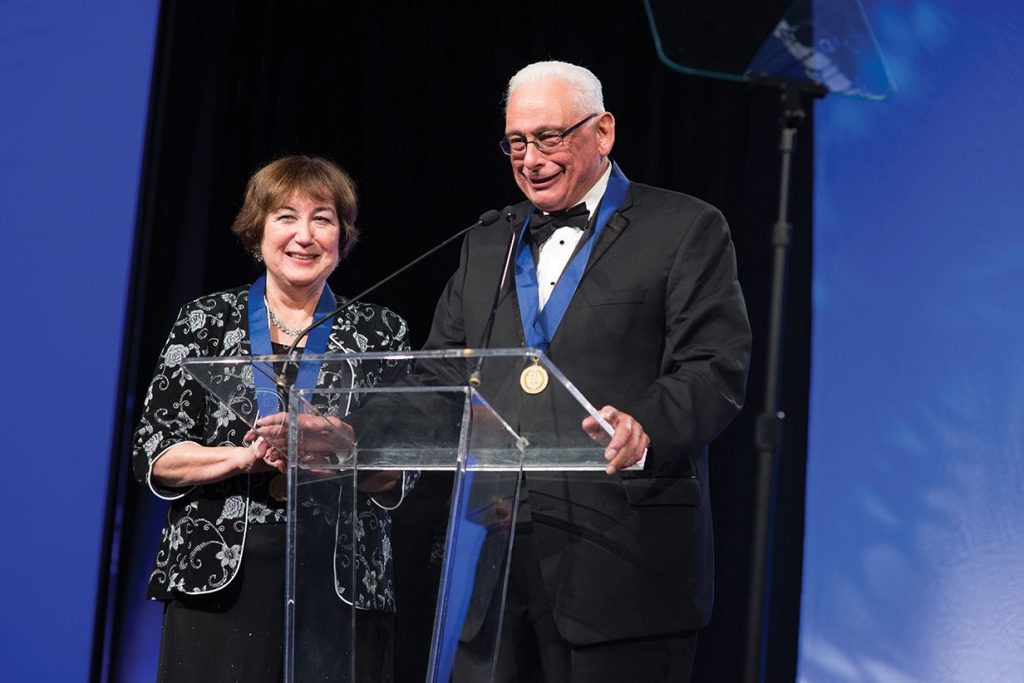Ray & Carmela Mellado:
Great Minds in STEM’s Founders

“It became clear to us that it wasn’t just the Latino and African American populations that were failing to reach parity. It was ALL underserved communities, including Native American, certain Asian communities, and even the white community, particularly in rural and underdeveloped regions of the country. The national security implications alone were already at crisis levels by the turn of the [21st] Century.” So, the organization changed its name from HENAAC to Great Minds in STEM in 2009 to reflect the needs of all the underserved communities nationwide it now addresses.
Hispanic Engineer, Fall 2020, page 26
Ray and his wife Carmela founded GMiS in 1989 first as the Hispanic Engineer National Achievement Awards Conference, or HENAAC. The conference grew out of a partnership with Tyrone Taborn and Career Communications Group, who together launched Hispanic Engineer Magazine in 1985 to tell the stories of successful Latino engineers and scientists to a national audience. The conference served as a platform to both honor and document the world-class achievements of Latino engineers and scientists, and to bring them face to face with Hispanic high school and college students aspiring to pursue careers in STEM to show them that careers in STEM were not only a possibility, but a reality.
Prior to founding Great Minds in STEM, Ray enjoyed a distinguished 21-year career in the private sector as a sales and marketing executive with the Xerox Corporation. In 1977, as a rising star at Xerox, Ray co-founded the Hispanic Association for Professional Advancement (HAPA), one of the first Hispanic employee associations in Corporate America and which served as a platform for him to network with Latino engineers and technology professionals for the first time. Prior to joining Xerox, Ray pursued a brief career as a high school teacher and coach at Cathedral High School, his alma mater. He would continue to serve as an assistant football coach for 10 years after leaving Cathedral, with successful stints at Garfield High School, East Los Angeles College, and Occidental College. Ray’s monumental contributions to STEM were recognized by multiple organizations and institutions. In 2009, NASA awarded him its Exceptional Public Service Medal, an honor limited to less than 1% of NASA’s contractor community. In 2010, Admiral Gary Roughead, the then-Chief of Naval Operations, presented Ray with the inaugural Admiral David Farragut Hispanic Diversity Champion Award. Whittier College awarded him a distinguished alumni award in 2011. In 2019, the Catholic Association for Latino Leadership (CALL) awarded Ray and Carmela their Angel Award for Excellence in Education for their work expanding STEM awareness and outreach across the country. And the Society of Hispanic Professional Engineers (SHPE) honored Ray with a Lifetime Member Award and a Founders Legacy Award presented by SHPE’s Los Angeles chapter. Ray was also proud of the work he did as a member of the NASA Task Force on STEM Education, which reports directly to the NASA Administrator; as a Board Member of the National Football Foundation; and as a member of the Cathedral High School Board of Trustees. He also served on many important STEM- and diversity- related boards and committees late into his career, including those convened by: the National Science Foundation; the National Academy of Engineering; California State University, Los Angeles; the United States Navy; Saint Mary’s College; the University of California System; the Association of Naval Service Officers (ANSO); and the Foundation for the Advancement of Science Education (FASE), producers of award-winning educational products that have earned three Peabody Awards. Ray was born and raised in the El Sereno neighborhood of Los Angeles, California, and died a few miles away in Pasadena. Along the way, he accomplished more than even he could have imagined, much of it alongside his wife, Carmela, with whom he enjoyed a blessed marriage of 51 years full of love, adventure, and impact. He is survived by Carmela as well as their 3 adult children, 5 (soon to be 6) grandchildren, 2 great grandchildren, three siblings, and countless cousins, nieces, nephews, godchildren, compadres and comadres, colleagues, former players and fellow coaches, and the thousands of engineers, scientists and students impacted by Great Minds in STEM’s work – past, present and future. •